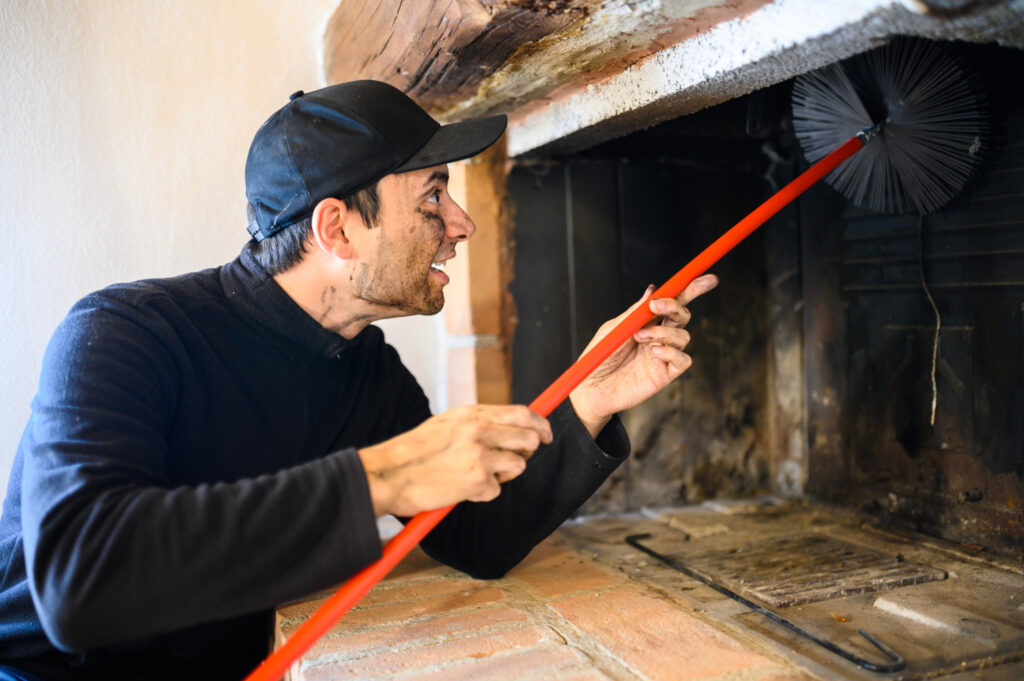Keeping your chimney clean is more important than you might think. It’s not just about appearances; a well-maintained chimney can make a big difference for your home. One of the main benefits of chimney sweeping is its role in preventing house fires. When your chimney gets filled with soot and creosote, it becomes a fire hazard. These substances are highly flammable and can lead to dangerous chimney fires if not regularly cleaned out.
But that’s not all. Regular chimney sweeping also helps extend the lifespan of your chimney. Over time, debris and deposits can wear down the chimney lining, leading to cracks and corrosion. Clearing out these harmful substances keeps your chimney in better shape for longer. Plus, a clean chimney works more efficiently, reducing the risk of other problems like blockages or poor ventilation.
Chimney maintenance might seem like a small task, but it has big benefits for your home. By keeping up with regular cleaning and inspections, you can ensure your chimney stays safe and functional for many years to come.
Chimney Sweeping and Fire Prevention
How Soot and Creosote Build-Up Can Cause Fires
When you burn wood in your fireplace, it produces smoke that contains unburned tar vapors. These vapors condense inside your chimney flue and form a black, sticky substance called creosote. Over time, creosote builds up and becomes thick. The thicker it gets, the greater the danger. Soot is another byproduct of burning wood. Like creosote, it can accumulate inside the chimney. Both soot and creosote are highly flammable. If enough of these materials build up, they can catch fire and cause a chimney fire.
The Science Behind Chimney Fires
Chimney fires can be intense and dangerous. When creosote ignites, it burns at extremely high temperatures. This heat can crack chimney walls and even reach your home’s wooden structure. The fire can spread rapidly, putting your entire house at risk. Sometimes, chimney fires make loud popping noises, and flames or dense smoke might shoot out from the top of the chimney. In severe cases, an unsuspecting family might not even know a chimney fire is occurring until it’s too late.
Regular Cleaning Reduces Risks
Routine chimney sweeping is essential to prevent chimney fires. By removing soot and creosote, you eliminate the materials that could potentially ignite. Experts recommend having your chimney cleaned at least once a year, or more often if you use your fireplace frequently. Regular cleaning ensures that your chimney stays in good condition, reducing the risk of fires and keeping your home safe. Scheduling professional sweeping services can save you from the dangers and damages caused by chimney fires.
Extending Your Chimney’s Lifespan
Prevention of Corrosion and Damage
A clean chimney is less likely to suffer from corrosion and damage. When soot and creosote build up, they can hold moisture, leading to rust and corrosion in metal components. Moisture trapped by debris can also cause brick and mortar to deteriorate. Regular chimney cleaning helps prevent these issues. By keeping the chimney free from harmful substances, you ensure its structural integrity for a longer time.
Benefits of Removing Blockages
Blockages in the chimney can be caused by various things like bird nests, leaves, or other debris. These blockages can obstruct the flow of smoke and gases, leading to poor ventilation and the buildup of dangerous fumes like carbon monoxide inside your home. Removing these blockages through regular sweeping keeps your chimney clear and your home’s air safe. It also allows your fireplace to operate more efficiently, as a clear chimney promotes better air circulation and combustion.
How Often Should You Sweep Your Chimney?
The frequency of chimney sweeping depends on how often you use your fireplace. For regular wood-burning fireplaces, an annual sweep is generally recommended. However, if you burn wood frequently, you might need to clean it more often. Other factors like the type of wood you use can also affect how quickly creosote and soot build up. Softwoods like pine produce more creosote than hardwoods like oak. Regular inspections can help determine when your chimney needs cleaning, ensuring it stays in the best condition possible.
Essential Chimney Maintenance Tips
Checklist for Post-Sweeping Care
After your chimney has been swept, follow these steps to keep it in top condition:
– Inspect the chimney cap to ensure it’s intact and free of debris.
– Check for any visible cracks or damage in the chimney’s structure.
– Ensure the damper functions correctly and closes tightly.
– Remove ashes from the fireplace regularly to prevent buildup.
– Store firewood in a dry place to avoid damp wood causing more soot.
– Monitor the condition of the firebox for any signs of wear or damage.
– Keep the area around the chimney clear of flammable materials.
– Have carbon monoxide detectors installed and check their batteries regularly.
Following these tips will help maintain your chimney’s health and ensure it continues to function safely.
Signs That Your Chimney Needs Attention
It’s essential to know when your chimney requires professional attention. Look out for these warning signs:
– A strong, unpleasant odor coming from the fireplace.
– Smoke filling the room instead of going up the chimney.
– Visible cracks or loose bricks on the chimney exterior.
– Water stains or moisture inside the firebox.
– Excessive creosote buildup that is difficult to remove.
– Animals or debris blocking the chimney.
If you notice any of these issues, it’s time to call a professional for an inspection and possible repairs.
DIY Safety Measures and When to Call a Professional
While you can perform basic chimney upkeep, some tasks require professional expertise. For DIY maintenance:
– Use a flashlight to check for visible blockages.
– Gently clean accessible parts of the chimney and firebox.
– Observe your chimney’s performance while using the fireplace.
However, always call a professional if:
– There’s extensive creosote buildup.
– You see significant structural damage.
– You experience recurring smoke problems.
A professional has the tools and knowledge to handle these more challenging issues safely and effectively.
Benefits of Regular Chimney Inspections
Early Detection of Potential Problems
Regular chimney inspections help identify problems before they become major issues. A trained inspector can spot early signs of damage or blockages that you might miss. Fixing these problems early prevents expensive repairs later. Regular inspections also ensure that your chimney is safe to use, reducing the risk of accidents.
Ensuring Efficient Operation
A well-maintained chimney operates more efficiently. When your chimney is clear of blockages and damage, smoke and gases can exit your home easily. This efficient operation means your fireplace works better, providing more heat and less smoke. It also helps your wood burn more completely, reducing the amount of creosote that forms.
Enhancing Home Safety and Air Quality
Regular inspections improve the safety and air quality in your home. A clean, well-functioning chimney ensures that smoke exits your home properly, preventing carbon monoxide from building up. It also reduces the risk of chimney fires. This means you can enjoy the warmth of your fireplace knowing your home is safe.
Conclusion
Taking care of your chimney is crucial for preventing fires and extending its lifespan. Regular sweeping removes dangerous soot and creosote, while maintenance helps avoid corrosion and blockages. Knowing the signs that your chimney needs attention ensures you can address problems promptly. Regular inspections catch issues early, maintaining efficient operation and improving home safety.
For professional chimney care, turn to Triple Crown Chimney Solutions. Our expert services keep your fireplace in top shape, enhancing safety and longevity. Schedule your inspection and chimney sweeping services with us today and enjoy the comfort of a worry-free fireplace.

